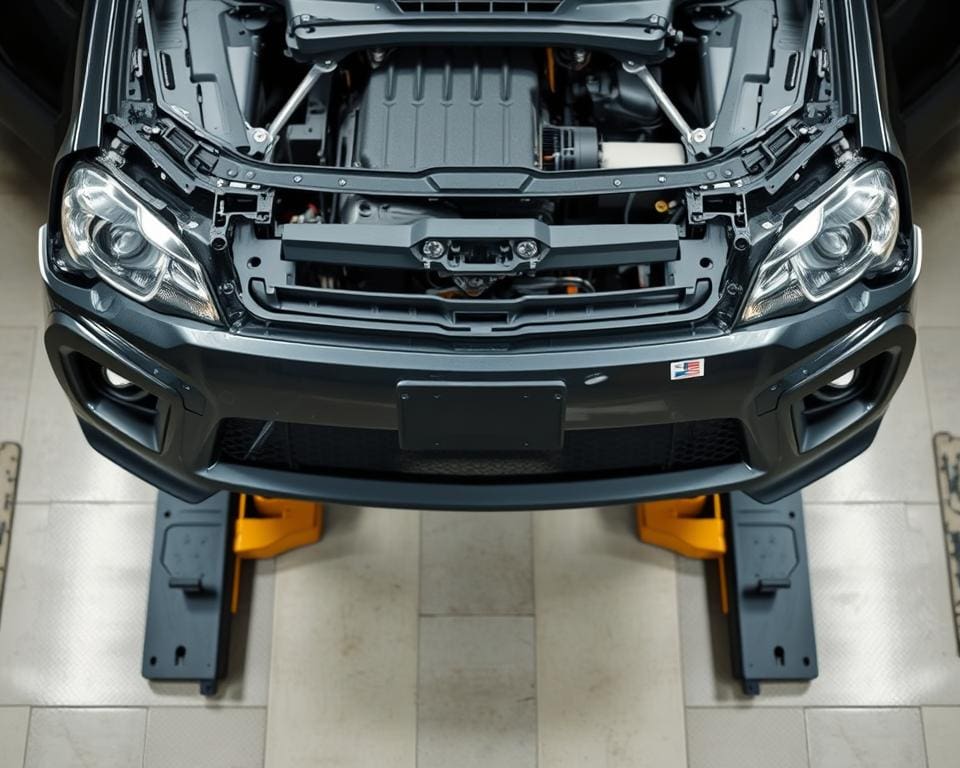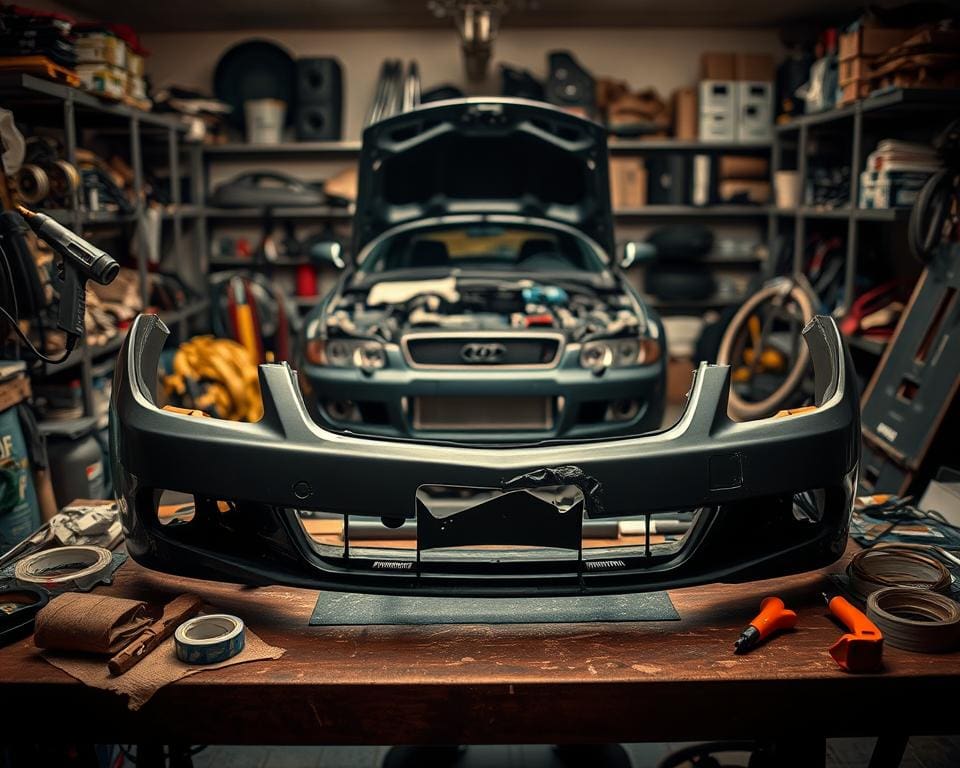Is it cheaper to have a bumper repaired?

When considering car damage, many car owners wonder if bumper repair is financially worthwhile. Repairing a bumper can often be cheaper than replacing it, but the final cost of bumper repair depends on several factors, such as the extent of the damage and the type of car. This section highlights the financial considerations surrounding bumper repair and discusses ways to save money without compromising quality and safety.
What are the costs of bumper repair?
Bumper repair costs can vary significantly. It’s important for car enthusiasts to know the average cost of bumper repair and which factors influence the final price. When repairing bumper damage, the severity of the damage plays a significant role in the cost.
Average cost of bumper repair
On average, the cost of repairing a bumper ranges from €150 to €600. This price depends on various factors, such as the type of damage and the required repair process. Minor scratches may cost less, while more extensive damage such as dents or paint damage can significantly increase the cost.
Factors that influence the price
Several factors influence the final cost of bumper damage repair. The following points are crucial:
- Type of damage (scratches, dents, paint damage)
- Make and model of the car
- Whether color matching and spraying are required
Is it cheaper to have a bumper repaired?
When considering bumper repairs, the question often arises whether repairing a bumper is cheaper than replacing it. The cost of replacing a bumper can range between €600 and €1200. Repairing offers an attractive alternative, making this process increasingly popular.
Comparison with replacing a bumper
When faced with the choice between repair and replacement, cost is often the determining factor. Hiring an expert for bumper repair generally results in lower expenses, especially compared to the cost of replacing a bumper. Furthermore, the original bumper is retained, which can contribute to the car’s value. Customers find that the benefits lie not only in the direct costs but also in the philosophy of vehicle preservation.
Long-term benefits of recovery
Bumper repair offers a range of long-term savings that can be realized in the future. Besides the immediate costs, insurance and bumper repair impact premiums. For insurance companies, retaining original parts can lead to lower premiums. Customers also benefit from the environmental advantages of repair, as it generates less waste.
The decision to have a bumper repaired rather than replaced offers financial and environmental benefits.
Types of damage to a bumper
Bumper damage can cause several problems. It’s important to understand the nature of the damage and the techniques used to repair it. This helps car owners make informed choices about their vehicles. Below, we discuss the most common types of bumper damage, such as removing bumper scratches and addressing paint damage.
Removing bumper scratches
Bumper scratches are a common form of damage and can be very aesthetically disturbing. Effective techniques are available for removing bumper scratches , often involving spot repair. This is a precision process that repairs minor damage locally. It offers the opportunity to restore the bumper’s appearance without replacing the entire bumper.
Paint damage and plastic bumper repair
Paint damage, such as discoloration or blistering, can also affect a bumper’s lifespan. It’s crucial to address this damage promptly to prevent further deterioration. Special techniques for plastic bumper repair are available for plastic bumpers. These methods involve the use of specific materials that ensure a durable and aesthetic finish. Properly addressing paint damage to a bumper can restore the vehicle to its peak condition.
The procedure of bumper repair
Bumper repair is a careful process consisting of several steps. From the initial damage assessment to the final finishing touches, each stage of the bumper repair process is crucial to ensuring a high-quality result. The most important steps for bumper repair are explained below.
Steps in the repair process
The first step in the repair process is a thorough inspection of the damage. This helps determine the extent of necessary repairs. Key steps include:
- Damage assessment and documentation.
- Prepare the surface by cleaning and sanding the damaged areas.
- Repairing any dents or scratches on the bumper.
- Spray the bumper to restore the damaged area to the correct color.
Bumper spraying and color match options
Spraying the bumper requires precision. It’s essential that the color matches the original paint perfectly. Various color-matching options are available, such as:
- Use of digital color matching systems to determine the exact shade.
- Mixing paint based on the car’s original color code.
- Apply multiple layers for an optimal end result.
Why choose professional bumper repair?
Professional bumper repair offers numerous advantages for car owners who want to maintain their vehicles. Using specialized services not only guarantees a quick repair process, but also quality and durability. This ensures a result that’s far superior to many DIY options.
Benefits of specialized services
The benefits of specialized services include:
- Expertise: Technicians are well-trained and experienced with various types of damage.
- Quality materials: High-quality materials are used to ensure an optimal finish.
- Warranty: Many professional providers provide a warranty on their work, which offers additional security.
- Time Efficiency: Professional repairs are typically faster than doing it yourself, meaning car owners spend less time away from their vehicle.
Popular repair services in Amsterdam
In Amsterdam, there are several providers specializing in bumper repair. Companies like Amsterdamautos.nl are popular for their customer-focused service and proven quality. Customer reviews often emphasize the speed and accuracy of their work. These professional bumper repair options are ideal for those looking for a reliable solution for damage to their cars.
Bumper damage repair: DIY options
Do-it-yourself bumper repair can be appealing to those looking to save money or learn new skills. DIY bumper repair offers the opportunity to address scratches and minor dents without calling a professional. This can be not only financially beneficial but also provide a sense of satisfaction.
Pros and cons of self-repair
When weighing the pros and cons of DIY repairs, it’s important to consider both the benefits and potential risks. One of the biggest advantages is the cost savings. Renting or purchasing the necessary materials to remove bumper scratches yourself can be significantly less expensive than professional repair.
- Cost savings: Avoiding labor costs saves a lot of money.
- Building skills: Learning new techniques contributes to personal development.
However, there are also disadvantages to doing it yourself. A small mistake can lead to further damage, ultimately costing more. Lacking the right tools and expertise can impact the quality of the repair. Here are some drawbacks to consider:
- Risk of damage: Poorly executed repairs may make the damage worse.
- Lack of experience: Insufficient knowledge may lead to insufficient results.
Researching budget-friendly options
For anyone looking for budget-friendly bumper repair, there are several options to consider. Comparing local repair services can quickly reveal where the more affordable bumper repair options are. Many car owners are surprised by the price differences between different companies, so it’s worth doing some thorough research.
In addition, offers and discounts from car dealers or garages can yield significant savings. They often offer seasonal discounts, making bumper damage repair more financially attractive. It’s also wise to consider alternatives to bumper damage repair, such as DIY repair or using affordable materials that can still produce a decent result.
Additionally, it’s wise to explore the options within your own insurance policy. Some policies cover part of the cost of bumper repair, which can significantly reduce your overall expenses. By choosing wisely and doing thorough research, everyone can ensure they find the best options for their bumper repair without breaking the bank.
FAQ
Is it cheaper to repair a bumper than replace it?
Yes, repairing a bumper is usually cheaper than replacing it. Repair costs vary depending on the damage, but are often between €150 and €600, while replacement can cost between €600 and €1200.
What is the average cost of bumper repair?
On average, bumper repair costs between €150 and €600. The price depends on factors such as the extent of the damage (scratches, dents, paint damage), the type of car, and whether color matching and spray painting are required.
How is bumper repair different from replacement in the long run?
Restoring a bumper can be more cost-effective in the long run because it preserves the original components, which can result in lower insurance premiums and a better residual value for the car.
What types of bumper damage can be repaired?
Common damage to bumpers includes scratches, dents, and paint damage. Techniques like spot repair are often effective for removing scratches, while plastic bumper repair can be used for other types of damage.
What are the steps in the bumper repair process?
The process begins with a damage assessment, followed by preparation and repair. The final step is spraying the bumper, with a focus on color matching for a seamless finish.
What are the benefits of professional bumper repair?
Professional bumper repair offers advantages such as expertise, use of quality materials, and work warranties. Companies like Amsterdamautos.nl offer specialized services that ensure customer satisfaction.
Are there DIY options for bumper damage repair?
Yes, there are DIY options available. Doing the repairs yourself can save money and build skills, but it’s important to remember that improper repairs can lead to further damage.
How can I find budget-friendly bumper repair options?
Budget-friendly options include comparing local repair services, searching for deals and discounts, and considering alternative self-repair facilities or using cheaper materials.

